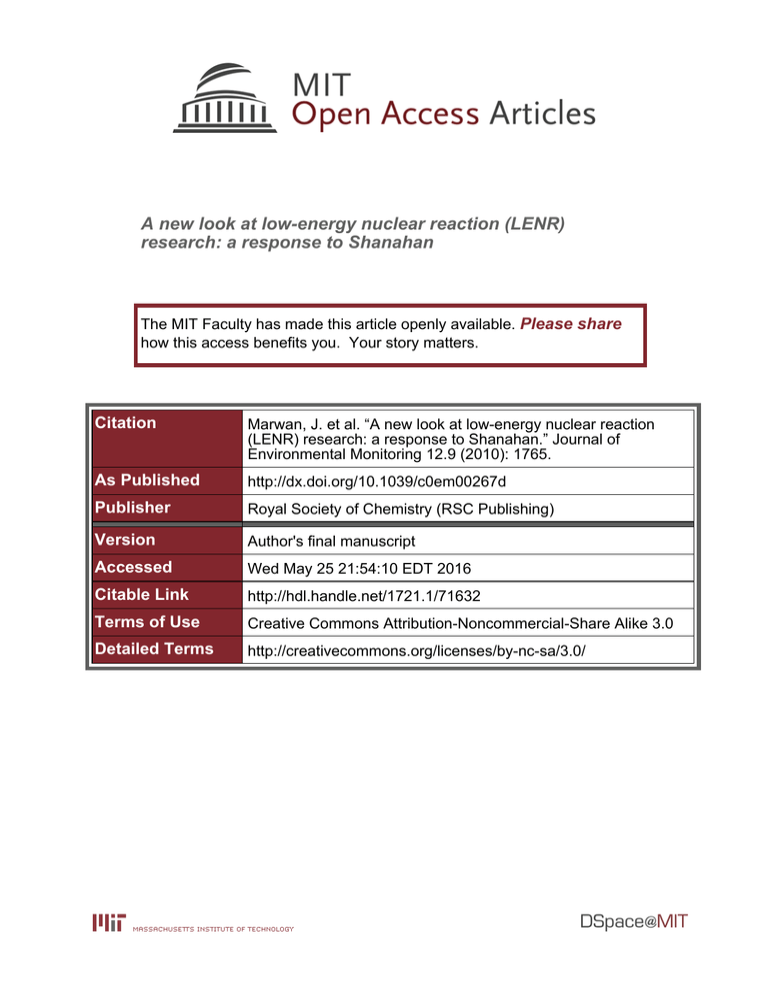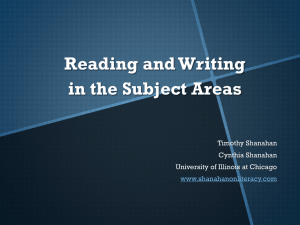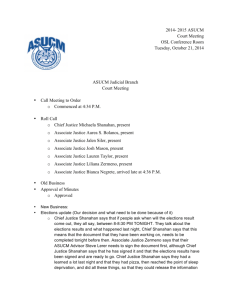A new look at low-energy nuclear reaction (LENR) Please share
advertisement

A new look at low-energy nuclear reaction (LENR) research: a response to Shanahan The MIT Faculty has made this article openly available. Please share how this access benefits you. Your story matters. Citation Marwan, J. et al. “A new look at low-energy nuclear reaction (LENR) research: a response to Shanahan.” Journal of Environmental Monitoring 12.9 (2010): 1765. As Published http://dx.doi.org/10.1039/c0em00267d Publisher Royal Society of Chemistry (RSC Publishing) Version Author's final manuscript Accessed Wed May 25 21:54:10 EDT 2016 Citable Link http://hdl.handle.net/1721.1/71632 Terms of Use Creative Commons Attribution-Noncommercial-Share Alike 3.0 Detailed Terms http://creativecommons.org/licenses/by-nc-sa/3.0/ A New Look at Low-Energy Nuclear Reaction (LENR) Research: A Response to Shanahan J. Marwan * Dr. Marwan Chemie, Rudower Chaussee 29, 12489 Berlin, Germany M.C.H. McKubre and F.L. Tanzella SRI International, 333 Ravenswood Ave., Menlo Park, CA 94025 USA P.L. Hagelstein MIT, 77 Massachusetts Ave., Cambridge, MA 02139, MA USA M. H. Miles Dixie State College, St. George, UT 84770 U.S.A. M.R. Swartz JET Energy Inc. Wellesley, MA 02481 (USA) Edmund Storms KivaLabs, Santa Fe, NM Y. Iwamura Advanced Technology Research Center, Mitsibishi Heavy Industries, Ltd., 1-8-1, Kanazawa-ku, Yokohama 236-8515 Japan P.A. Mosier-Boss SPAWAR Systems Center Pacific, Code 71730, San Diego, CA 92152 USA L.P.G. Forsley JWK International Corp., Annandale, VA 22003 USA ABSTRACT In his criticisms of the review article on LENR by Krivit and Marwan, Shanahan has raised a number of issues in the areas of calorimetry, heat after death, elemental transmutation, energetic particle detection using CR-39, and the temporal correlation between heat and helium-4. These issues are addressed by the researchers who conducted the original work that was discussed in the Krivit-Marwan (K&M) review paper. 1. INTRODUCTION In 1989, the subject of “cold fusion,” nowadays known as Low Energy Nuclear Reactions (LENR), was announced with great fanfare, to the chagrin of many people in the scientific community. However, the significant claim of its discoverers, Martin * Corresponding author: info@marwan-chemie.fta-berlin.de; +49 30 6392 2566 1 Fleischmann and Stanley Pons, excess heat without harmful neutron emissions or strong gamma radiation, involving electrochemical cells using heavy water and palladium, has held strong. In recent years, LENR, within the field of condensed matter nuclear science, has begun to attract widespread attention and is regarded as a potential alternative and renewable energy source to confront climate change and energy scarcity. The aim of the research is to collect experimental findings for LENR in order to present reasonable explanations and a conclusive theoretical and practical working model. The goal of the field is directed toward the fabrication of LENR devices with unique commercial potential demonstrating an alternative energy source that does not produce greenhouse gases, long-lived radiation or strong prompt radiation. The idea of LENR has led to endless discussions about the kinetic impossibility of intense nuclear reactions with high coulomb barrier potential. However, recent theoretical work may soon shed light on this mystery. As a result of on the New Energy Technology Symposium at the American Chemical Society in Salt Lake City in 2009, the symposium organizers (K&M), were invited to write a summary of the presentations given at this meeting and overall to introduce and briefly review the topic of Low Energy Nuclear Reactions. The article titled “A New Look at Low-Energy Nuclear Reaction Research” mainly includes and discusses a range of experimental results in light of LENR effects with access to new sources and theoretical explanations.1 With this writing we intended to give insight into this controversial subject and to help the audience re-evaluate their perspective on LENR for a possible alternative energy source and to create appropriate Energy Sustainability Concepts. In the following we respond to the critiques K. Shanahan has revealed in his rebuttal of our paper. 2. DISCUSSION 2.1 Calorimetry Shanahan manufactured beads for LENR calorimetry experiments in conjunction with EarthTech (Austin, Texas) in the mid-90s. Swartz noted in his published analysis of the experiment2 that Shanahan may have ignored evidence of excess power and a possible Optimum Operating Point (OOPs) correlating applied and excess power. Nearly fifteen years later, Shanahan followed this up with a commentary comprised of unsubstantiated blanket statements critical of the field. He reasons by syllogism from particular examples (often misunderstood) to general conclusions that clearly cannot apply in all of the examples of anomalous heat production observed in a wide variety of experimental configurations involving different kinds of calorimeters, e.g. isoperibolic, Seebek, and mass flow. To explain the excess heat in these experiments, Shanahan invokes what he calls a Calibration Constant Shift (CCS). This CCS is nothing more than a hypothesis and should be stated as such (CCSH). There is no experimental evidence 2 that it occurs, especially at the level of ±780 mW stated by Shanahan. Furthermore, Shanahan does not specify mechanisms by which a calorimeter thermal calibration can change in such a way that, just during the periods of putative excess thermal power production, the calibration constant is different from its initial and final calibrated value. He employs the calibration constant shift hypothesis (CCSH), unquantified, with the logic that if this can happen in one experiment or calorimeter type, then it must be presumed to happen in all. To dispel this notion, the excess heat results obtained using two completely different types of calorimeters will be discussed. The excess power measurements done at the China Lake used an isoperibolic-type calorimeter. Periodic calibrations over a five year period showed no significant changes in the heat transfer coefficients for the China Lake calorimeters.3 However, the isoperibolic calorimeters used by Miles at the New Hydrogen Energy Laboratory (NHE) in Japan incorporated an automated Joule heat pulse. The calorimeter was calibrated at least once every second day. From this, the coefficients of thermal calibration are deduced by backwards integration fitting of the calorimeter response to this known input thermal power pulse. Calibrations were performed before, after and during the production of excess thermal power. The excess power measurements3 were summarized by the following six conclusions: (1.) The excess power effect was typically 5 to 10% larger than the input power. The largest excess power effect was 30% (2.) The excess power in terms of the palladium volume was typically 1 to 5 W/cm3 (3.) Long electrolysis times ranging from 6 to 14 days were required before the onset of the excess power for Pd rod cathodes (4.) Excess power production required a threshold current density of 100 mA/cm2 or higher (5.) Overall, only 30% of the experiments produced excess power (6.) The success ratio in obtaining excess power varied greatly with the source of the palladium It would be nearly impossible to obtain these conclusions if the excess power was due to Shanahan’s random CCSH. Furthermore, SRI obtained very similar conclusions using a totally different type of calorimeter over this same time period.4,5 The SRI calorimeter was based upon mass flow in which the thermal efficiency reflects the fraction of the total heat removed by convective flow, i.e., Φ = QConvection / [QConvection + QConduction + QRadiation] (1) A Mass Flow Calorimeter designed with high thermal efficiency, Φ, can operate as a first principles device with no calorimeter specific calibrations. Nevertheless, the calorimeter was periodically calibrated using an internal resistor. The maximum error was determined to be ±50 mW. For a mass flow calorimeter with Φ = 99%, only 1% of the measured heat output is subject to the vagaries of geometric effects on conduction and radiation. The remaining 99% is determined solely from temperature, mass flow rate and the heat capacity of the convecting fluid. None of these measurements are subject to calibration drift and can be measured and calibrated independent of the calorimeter. Thus the CCSH 3 can account for an excess power of at most (and actually much less than) 1% of the output power in the example given. Reported excess power numbers are typically >10% of the input electrical power. The CCSH can thus be shown quantitatively to fail in all cases of excess power reported in mass flow calorimeters. The SRI results typically yielded 5 to 10% excess power with a maximum of 28% excess power; the excess power was 1-5 W/cm3 on the average; the initiation time was on the order of 300 hours for 1-4 mm Pd rods; the threshold current density ranged from 100-400 mA/cm2; and the success rate varied greatly with the source of the palladium.4,5 Two laboratories working completely independently using different types of calorimeters (isoperibolic vs. flow) could not arrive at these similar conclusions if the excess power was due to random calibration constants shifts. Like Miles of China Lake, the SRI group showed that the rate of heat production is determined by applied current. However, the SRI group also discovered that heat production correlates with the average D/Pd ratio of the cathode. A similar correlation between these variables and energy production has been observed in every subsequent study done world-wide when such measurements are made. This consistency in the behavior of two independent variables shows that in many cases the anomalous energy is not the result of error in measurement. Since the CCSH has no reason for bias in sign it may equally increase or decrease the measured output and thus excess power. In no case that we are aware of have significant “negative excess” powers been observed in FPE experiments except in transient departures from the steady state. Unless a reason is given for asymmetry in the hypothesized mechanism (or any mechanism given and quantified at all), then the CCSH logically fails. Finally, this isn’t the first time Shanahan has raised these spurious arguments. He’s applied them twice before, in 20026 and 2005,7 prompting a published response from Storms in 2005.8 In his response to Shanahan’s criticisms, Storms notes, “The assumptions used by Shanahan to explain anomalous heat claimed to result from cold fusion are shown to be inconsistent with experimental observation.” Shanahan’s assertions are no more true now than they were five and eight years ago. 2.2 Heat after Death (HAD) The poorly-chosen term ‘Death’ referred to the termination of input electrical power in Pons’ cell, which by definition occurs in the HAD region. In the original “HAD” reported by Pons and Fleischman, the electrolysis cell had finally run out of heavy water (due to the electrolysis) thereby unintentionally and inadvertently creating the region of no further input electrical power, because the electrical circuit was ‘open circuited’. Shanahan first mis-characterizes this as a phenomenon of a thermodynamically open cell in which “the electrolysis cell is allowed to lose enough electrolyte via evaporation, entrainment, and electrolysis that electrical contact is broken and current flow stops.” The phenomenon is more generally the observation of continued heat generation after the cessation of electrochemical current generation by any means (normally, disconnecting 4 the power supply). While not unusual, this phenomenon is sufficiently common, clear and distinctive to have evoked comment by several researchers. Shanahan seeks to account for a putative mis-measurement of heat in a single 1993 example of HAD cited in the K&M review. This he does in terms of his ad hoc Calibration Constant Shift hypothesis (CCSH) and/or as the result of the catalyzed burning of (previously) absorbed deuterium, neither of which does he trouble to quantify, leaving the impression that this is “common sense” – although not common or sensible enough for the experimenters who actually observed it, to be aware of it. He then argues from this (mis)analysis of one example of HAD to a general claim that all must be false. In the 1993 example addressed by K&M and Shanahan, the anomaly observed and reported by Fleischmann and Pons was simply (but remarkably) that the temperature sensed close to an exposed cathode stayed high for a period longer than was previously experienced or anticipated. The significant point of this experiment (unmentioned by Shanahan) was that the electrolyte had evaporated by boiling with input electrical power far less than was needed to do so by simple Joule heating. If Shanahan had troubled to calculate the energy needed to evaporate a significant fraction of the cell electrolyte volume before the cathode was exposed, or added to it the energy required to maintain the cathode at elevated temperature after exposure he would have found that, even though the former is much greater than the latter, both exceed by large factors the heat of formation of D2O from cathode-absorbed deuterium. Miles had an experiment that produced the “heat-after-death” (HAD) effect when he was at NHE in Japan. This experiment used a Pd-B rod cathode prepared by M.A. Imam of the U.S. Naval Research Laboratory (NRL), and complete details of this experiment are available.9 An excess power greater than 9 W was observed prior to the cell being driven to dryness (see Ref. 9, Fig. A.22). Furious boiling and swirling actions were observed that were centered around the Pd-B cathode indicating that the cathode was the hottest point in the cell. During this boiling phase, most of the gas in the cell would be D2O vapor rather than hydrogen and oxygen as stated by Shanahan. Furthermore, the gases exiting the cell were conducted through about two meters of glass tubing to a balance in order to continuously measure the amount of D2O that had boiled away. The excess power continued at about the same level after the cell boiled dry and then gradually decayed over several hours. Shanahan’s argument for explaining this HAD fails because there would be very little oxygen in a cell filled with D2O vapor. If this HAD effect depended upon oxygen, it would initially be small when the cell first boiled dry and then increase as air is gradually drawn back into the cell through the two meters of glass tubing. This was not observed,5 thus Shanahan’ hypothesis for the HAD effect is invalid. 2.3 Transmutation With regards to transmutation, Shanahan impugns the work done by both Mizuno et al. and Iwamura et al. Figure 9 in the K&M review1 shows Energy Dispersive X-Ray spectrometery (EDX) analysis done, by Mizuno et al., on a Pd rod before and after it produced excess heat during electrolysis. In his critique, Shanahan suggests that the observed new elements on the Pd rod are the result of contamination. Shanahan contends 5 that metals from the cell components leach into the solution and are transported onto the cathode. What Shanahan does not indicate is that Mizuno et al.10,11 used very pure and carefully analyzed materials in their experiments. During the course of the experiments, electrolysis was done at 150°C under pressure in an electrolyte containing D2O+LiOH after it had been pre-purified for seven days by electrolysis using sacrificial platinum electrodes. Furthermore, the stainless steel cell was sealed and protected by a thick coating of Teflon. In these experiments, electrolysis was continued for 32 days. Upon completion of the experiment, the palladium cathode was analyzed using EDX , AES (Auger electron spectroscopy), SIMS (secondary ion mass spectrometry) and EPMA (electron probe microanalyser). The Figure 9 in the K&M review only shows the EDX results. The other analytical methods confirmed this analysis and found other elements such as As, Ga, Sb, Te, I, Hf, Re, Ir, Br and Xe, several of which had abnormal isotopic ratios. While Shanahan might argue that the chromium (Cr) and iron (Fe) came from exposed stainless steel, this cannot explain the copper (Cu) and titanium (Ti), which were not found initially in the materials, and which showed abnormal isotopic ratios. Nor can it explain the anomalous isotopic distribution observed for Cr.10 Iwamura and his co-workers conducted gas permeation experiments.12 These experiments used sandwich structures consisting of alternating thin layers of CaO and Pd. On one side of the sandwich, Iwamura et al. deposited a thin elemental layer. This elemental layer is referred to as the ‘source element’ in the K&M review.1 The sample was then mounted in a vacuum chamber, with the elemental layer facing the upstream side of the diffusion barrier. The sample was heated to 70°C and D2 was allowed to diffuse though the structure. During the course of the experiment, the elemental composition of the ‘source element’ layer was monitored in-situ and in real-time using Xray photoelectron spectroscopy (XPS). As the D2 passed through the sandwich structure, the elemental composition of the thin ‘source element’ layer was observed to change as a function of time. As the concentration of the source element decreased, the amount of product element increased. Shanahan states these transmutation results were due to contamination. However, either Pr or Mo was only observed when Cs or Sr, respectively, was deposited on the Pd/CaO multilayer prior to permeation. Neither was otherwise observed. Furthermore, if Mo came from vacuum chamber contamination, then it should be observed with bare Pd instead of only with a Pd/CaO multilayer, but it wasn’t. This effect did not occur when CaO was replaced by MgO, or when H2, was used even though the other conditions remained unchanged. Hence, the deuterium permeation of a Cs or Sr layer in the Pd/CaO multilayer was necessary for elemental transmutation. Shanahan also referenced NRL’s assertion that the inner wall of Iwamura’s balance, and nowhere else in his laboratory, was contaminated with Pr. Iwamura used the balance twice for each sample for 10 seconds each time. If Pr from the inner wall of the balance contaminated the Pd sample, the lower part of the Pd multilayer sample should also have been contaminated: it wasn’t. Praseodymium should have consistently contaminated both control samples and multilayer samples, but it didn’t. 6 The ion implanted Cs concentration continuously decreased from the surface. There was no Pr in the sample prior to permeation, but after deuterium permutation, the Cs concentration decreased in inverse proportion to the increased Pr concentration found in the top 10 nm of the surface. Prior to permeation, the Cs depth profiles in both samples were nearly equivalent, and thus, Cs atoms didn’t diffuse. It is unlikely a Pr contamination impurity migrated as Pr was only found within 10 nm of the surface. Consequently, neither NRL’s contaminated balance hypothesis nor Shanahan’s suppositions account for the observations of elemental transmutation. 2.4 Energetic Particle Detection Using CR-39 In their review, K&M1 discuss the results of an SRI replication of a Pd/D codeposition experiment done using CR-39, a solid state nuclear track detector. In his critique, Shanahan implies that little or no control experiments had been done to test conventional origins for the tracks observed in the CR-39 detectors used in the experiments. He further suggests that the tracks that have been observed in the CR-39 detectors are due to either O2 attack or ‘shockwaves’ resulting from explosions due to D2/O2 recombination on the Pd surface. He also states that the triple track shown in the review article is actually overlapping tracks. In actuality, SPAWAR had done an exhaustive series of control experiments that showed that the tracks were not due to radioactive contamination of the cell components nor were they due to mechanical or chemical damage.13,14 The time duration of these control experiments were the same as that used in the Pd/D co-deposition experiments. Also, the experimental results summarized in Figure 1 rule out both O2 attack and shockwaves as the source of the tracks. It was reported that when Pd/D co-deposition was done on Ni screen, in the absence of an external electric/magnetic field, no tracks were observed on the CR-39 detector.13 Instead the impression of the Ni screen was observed, Figure 1a. The observed damage is consistent with X-ray/gamma ray damage. When Pd/D co-deposition was done on Ni screen in the presence of an external electric/magnetic field, tracks were observed, as shown in Figure 1b. A high track density is observed inside the eyelets of the Ni screen where the Pd plated out. In contrast, tracks in CR-39 were observed in Pd/D co-deposition experiments done on Ag, Au, and Pt wires in both the presence and absence of an external electric/magnetic field.13 The effect of cathode material on the generation of energetic particle tracks in CR-39 is still not understood. Recently, Pd/D co-deposition experiments were done on a composite electrode, Figure 1c, in the absence of an external electric/magnetic field. The composite electrode was a Ni screen. As shown in Figure 1c, half the Ni screen is bare. Metallic Au has been plated on the other half. At the end of the experiment, the detector was etched and analyzed. The results show that no tracks were obtained on the bare half of the cathode, Figure 1d. The impression of the Ni screen is observed. However, tracks were obtained on the Au-coated Ni screen, Figure 1e. Both halves of the cathode experienced the same chemical and electrochemical environment at the same time. If Shanahan’s suppositions were correct that the pitting in CR-39 is caused by either explosions due to chemical reactions or to O2 attack, those reactions would have occurred on both the bare Ni and Au-coated Ni halves of the cathode and both halves would have shown pitting of the CR-39 detector. This was not observed. 7 Triple tracks in CR-39 are diagnostic of the carbon breakup reaction due to interactions with≥ 9.6 MeV neutrons and is the most easily identifiable neutron interaction with the detector.15 These triple tracks have been observed on both the front and back surfaces of the CR-39 detectors.15,16 They have not been observed in CR-39 detectors used in either control experiments or blanks. The triple track shown in Figure 12 of the K&M review is similar to those observed in CR-39 detectors that have been exposed to a DT neutron source. Figure 2 compares Pd/D co-deposition generated triple tracks with those created upon exposure to a DT neutron source. Both sets of tracks are indistinguishable. Figures 2a and b are examples of symmetric triple tracks while those in Figure 2c are asymmetric triple tracks. 2.5 Temporal Correlation between Heat and 4He The China Lake experiments on the correlation of heat and helium-4 production carefully ruled out contamination.3,17 Control cells were run in the same manner as the cells that produced excess power. Excess helium-4 was measured in 18 out of 21 cells that produced excess heat. None of the 12 control cells that yielded excess heat nor showed excess helium-4 production. The random probability of obtaining the correct heat/helium-4 relationship in 30 out of 33 studies is 1:750,000 (see Appendix C of Ref. 2). Furthermore, it is very unlikely that random errors due to contamination would consistently yield helium-4 production rates in the appropriate range of D+D fusion of 1011 – 1012 atoms/s per watt of excess power. 3,17 Case18 reported production of extra energy by nano-particles of palladium on the surface of charcoal when the material was exposed to D2 gas at temperatures up to 175°C. Mckubre et al.19 replicated the claims. The results of this experiment are shown in Figure 3a. This is the Figure 6 in the 2004 report prepared by Hagelstein et al.20 that Shanahan discusses. This plot illustrates the real-time correlation between excess heat and the growth of 4He concentration in a metal-sealed, helium leak-tight vessel that was observed in the SRI replication of the Case experiment. In his critique, Shanahan briefly touches on the quantitative and temporal correlation of excess heat and 4He production with an odd argument posed as a rhetorical question: “If in fact there is no excess heat, then what exactly is being plotted on the Y axis?” Where does the “fact” that “there is no excess heat” come from? It comes from the strained logic that the CCSH “explains all excess heat results.” As discussed above, CCSH has no validity. Plotted on the X axis of Figure 3a is the increased level of 4He measured in samples drawn from a helium-leak-tight vessel. Again in his critique, Shanahan asks: “If there is no proof that the observed He is not from a leak, then how does one know that is not what is being plotted on the X axis?” This is easily explained. The shape of the measured 4He vs. time curve is quantitatively different from that of a convective or diffusional leak of ambient 4He into the closed cell. The measured and plotted [4He] first remains constant (no leak), then rises approximately linearly to roughly twice the ambient air background level. A shape consistent with the hypothesis Shanahan proposes would be exponential with greatest slope at time zero and rising asymptotically to the environing background level (5.22 ppmV). So an explanation invoking an in-leak from the ambient can be seen to fail quantitatively. 8 Figure 3b shows plots of the 4He concentration, [4He], measured as a function of time. This is the Figure 12 that Shanahan discusses in his critique of the SRI replication of the Case experiment. In his critique, Shanahan questions the decrease in [4He] after day ~30. The original experimenters also noticed this, questioned it, and sought the explanation experimentally, quantitatively and with reference to the literature. At elevated temperatures 4He absorbs or adsorbs to a modest degree into or onto carbon; the measurements reported therefore reflect a slight systematic under-measurement of the [4He] consistent with the measured Q value correlation between the rates of heat and helium production. Shanahan impugnes the mass spectroscopist by pretending superior knowledge of variability of [4He] in room air. The original reports indicate that each data helium point was developed by measuring a 4He in D2 standard, the sample and room air. All three measurements are made for each data point. There is no fluctuation of [4He] in room air as any level of actual experience or a simple calculation of the volume of helium needed would show. Nor is there an “unknown and therefore uncontrolled systemic error in the mass spectrometer results”. 3. CONCLUSIONS Despite Shanahan’s unsubstantiated allegations, LENR researchers are well aware of the necessity for controls to verify proper instrument function while eliminating more prosaic explanations for the observed effects. Indeed, peer-reviewed published papers and conference presentations have long disproved Shanahan’s chemical/mechanical suppositions regarding LENR observations. Furthermore, contrary to Shanahan’s assertions, the observed effects are often several orders of magnitude larger than the measurement errors. For example, in a variety of experiments, the solid-state nuclear track detector background was less than 1 track/mm2 whereas the signal exceeded 10,000 tracks/mm2! Both Swartz and a team at Energetics have reported excess power an order of magnitude or greater than the input power in electrolytically driven systems. Similarly, LENR researchers have replicated the LENR effect in a variety of electrolytic and gas-loaded systems. First Miles, and later both De Ninno and an exhaustive effort by SRI, correlated 4He production with heat in electrolytically-loaded systems. Later, SRI replicated the 4He-heat correlation in gas-loaded systems with Case’s Pd/carbon catalyst and Arata’s double-structured electrode. Excess heat production in Szpak and Mosier-Boss’ electrolytic Pd/D co-deposition system was first measured by Miles and then replicated by Letts. Kitimura and Ahern have both replicated excess heat from Arata and Zhang’s gas-loaded Pd/ZrO2 nanostructures. However, reproducible heat-production in bulk Pd is still an issue, with much to be learned about Pd metallurgy and batch-to-batch variability. Indeed, material irreproducibility plagued the semiconductor field for decades and is still a concern with high Tc superconductors. This is not a new phenomenon for a new and emerging field. In conclusion, success of LENR has been difficult to achieve because of multiple factors including significant Pd/D loading, adequate loading times (sometimes weeks), loading rate, deuterium flux, lattice prehistory, and electrolyte/cathode compositions. 9 References 1. S.B. Krivit and J. Marwan, J. Environ. Monitoring 2009, 11, p. 1731. 2. M. Swartz and G. Vernon, “The Importance of Controlling Zero-Input Electrical Power Offset”, Journal of New Energy 1998, 3, p. 15. 3. M.H. Miles, B.F. Bush and K.B. Johnson, “Anomalous Effects in Deuterated Systems”, NAWCWPNS TP 8302, September 1996 4. M.C.H. McKubre, S. Crouch-Baker, R.C. Rocha-Filho, S.I. Smedley, and F.L. Tanzella, “Isothermal Calorimetric Investigations of the D/Pd and H/Pd Systems,” J. Electroanal. Chem., 1994, 368, p 55. 5. M.C.H. McKubre, S. Crouch-Baker, A.K. Hauser, S.I. Smedley, F.L. Tanzella, and S.S. Wing, “Concerning Reproducibility of Excess Power Production”, in Proceedings of the Fifth International Conference on Cold Fusion, 9-13 April 1995, Monte Carlo, Monaco, p. 17. 6. K. Shanahan, “A Systematic Error in Mass Flow Calorimetry Demonstrated,” Thermochim. Acta , 2002, 387, p. 95. 7. K. Shanahan, “Comments on ‘Thermal Behavior of Polarized Pd/D Electrodes Prepared by Co-deposition,” Thermochim. Acta, 2005, 428, p. 207. 8. E. Storms, “Comment on Papers by K. Shanahan that Propose to Explain Anomalous Heat Generated by Cold Fusion,” Thermochim. Acta, 2005, 441, p. 208. 9. M.H. Miles, M.Fleischmann, and M.A. Imam, “Calorimetric Analysis of a Heavy Water Electrolysis Experiment Using a Pd-B Alloy Cathode”, NRL/MR/6320-01-8526, March 26, 2001. 10. T. Mizuno,T. Ohmori, and M. Enyo, “Anomalous Isotopic Distribution in Palladium Cathode after Electrolysis,” J. New Energy, 1996, 1, p. 37. 11. T. Mizuno, T., et al., “Confirmation of the Changes of Isotopic Distribution for the Elements on Palladium Cathode after Strong Electrolysis in D2O Solutions,” Int. J. Soc. Mat. Eng. Resources 1998, 6, p. 45. 12. Y. Iwamura, M. Sakano and T. Itoh, “Elemental Analysis of Pd Complexes: Effects of D2 Gas Permeation”, Jpn. J. Appl. Phys. 41, 4642-4648 (2002). 13. P.A. Mosier-Boss, S. Szpak, F.E. Gordon, L.P.G. Forsley, Use of CR-39 in Pd/D Codeposition Experiments, Eur. Phys. J. Appl. Phys. 2007, 40, p. 293. 10 14. P.A. Mosier-Boss, S. Szpak, F.E. Gordon, L.P.G. Forsley, Detection of Energetic Particles and Neutrons Emitted During Pd/D Co-deposition, in Low-Energy Nuclear Reactions Sourcebook Volume 1, ed. J. Marwan and S. Krivit, American Chemical Society, Oxford University Press, Washington, D.C., 2008, p. 311. 15. A.S. Roussetski, “Application of CR-39 Plastic Track Detector for Detection of DD and DT-Reaction Products in Cold Fusion Experiments,” in 8th International Conference on Cold Fusion, Italian Physical Society, Bologna, Italy, 2000. 16. P.A. Mosier-Boss, S. Szpak, F.E. Gordon, L.P.G. Forsley, “Triple Tracks in CR-39 as the result of Pd-D Co-deposition: Evidence of Energetic Neutrons,” Naturwiss. 2008, 96, p. 135. 17. M.H. Miles, “Correlation of Excess Enthalpy and Helium-4 Production: A Review”, in Condensed Matter Nuclear Science (ICCF-10 Proceedings), P.L. Hagelstein and S.R. Chubb, Editors, World Scientific, New Jersey, 2006, pp. 123-131 18. L.C. Case, “Catalytic Fusion of Deuterium into Helium-4.” in The Seventh International Conference on Cold Fusion, ENECO, Inc., Salt Lake City, UT, 1998. 19. M.C.H. McKubre, et al. “Finite Element Modeling of the Transient Colorimetric Behavior of the MATRIX Experimental Apparatus: 4He and Excess of Power Production Correlation Through Numerical Results,” in 8th International Conference on Cold Fusion, Italian Physical Society, Bologna, Italy, 2000. 20. P. Hagelstein, M. McKubre, D. Nagel, T. Chubb, R. Hekman, “New Physical Effects in Metal Deuterides”, 2004, Washington: US Department of Energy, http://web.archive.org/web/20070106185101/www.science.doe.gov/Sub/Newsroo m/News_Releases/DOE-SC/2004/low_energy/Appendix_1.pdf (manuscript) 11 FIGURES Figure 1. CR-39 results for Pd/D co-deposition done on Ni screen cathodes. (a) Photogragh of CR-39 used in an experiment performed in the absence of an external field. The impression of the Ni screen is observed. Photograph was obtained from S. Krivit, New Energy Times. (b) Photomicrograph of CR-39 used in an experiment performed in the presence of an external magnetic field, 20× magnification. Tracks are observed inside the eyelets of the Ni screen. (c) Photograph of the composite electrode used in a Pd/D co-deposition experiment done in the absence of an external electric/magnetic field. The top half of the cathode is bare Ni screen, the bottom half is Au-plated Ni screen. (d) Photomicrograph of CR-39 in contact with the bare Ni half, 20× magnification. The impression of the Ni screen is observed. (e) Photomicrograph of CR39 in contact with the Au-coated Ni half, 1000× magnification. Tracks are observed. Figure 2. Comparison of Pd/D co-deposition generated and DT generated triple tracks. 12 Figure 3. Summary of SRI results on the Case replication. (a) Plot showing correlation between 4He and excess heat where ○ are gradient data points (y = 18.36 x, R2 = 0.99); - - - - is gradient Q = 31 ± 13 MeV/atom; ● are differential data points (y = 18.89x, R2 = 0.95); ─ is differential Q = 32 ± 13 MeV/atom. (b) Helium-4 increase in sealed cells containing Pd on C catalyst and D2 (H2) gas where - - - - is 4He in room air at STP; ■ is SC1; ● is SC2; ○ is SC3.1; ■ is SC3.2; □ is SC4.1; and ∆ is SC4.2. 13







